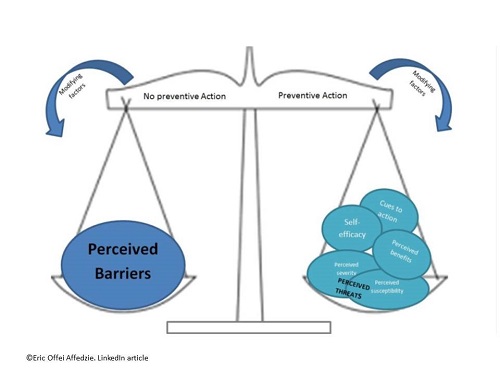- Home - News
- TWI News | TV
- Polls
- Year In Review
- News Archive
- Crime & Punishment
- Politics
- Regional
- Editorial
- Health
- Ghanaians Abroad
- Tabloid
- Africa
- Religion
- Election 2020
- Coronavirus
- News Videos | TV
- Photo Archives
- News Headlines
- Press Release
Opinions of Friday, 14 July 2017
Columnist: Eric Offei Affedzie
The Health Belief Model: A conceptual framework for preventing HIV and AIDS through the ABC model
Human Immunodeficiency Virus (HIV) infection which causes Acquired Immune Deficiency Syndrome (AIDS) if not treated is still a major global health threat that demands aggressive prevention interventions to bring it under control.
There are many behavior change communication approaches for preventing HIV and AIDS, the most popular being the ABC model. In this article, the ABC model of HIV and AIDS prevention is revisited and discussed from the perspective of the Health Belief Model.
The Health Belief Model (HBM) is a conceptual framework for predicting and explaining whether a person will perform an action necessary for preventing a specified health condition or not.
It was posited by Hochbaum, Rosenstock and Kegels (1950) and states that whether a person will take action to prevent an adverse health condition depends on their perceptions or beliefs about the severity of the condition, susceptibility to the condition and the activities necessary for preventing the condition.
In this article, the Health Belief Model is being applied to the ABC model of HIV and AIDS prevention to suggest ways of making it more effective. The ABC model is a popular behavior change communication campaign targeting people of all age groups, gender and sexual orientations to prevent getting infected with HIV mainly through sexual transmission.
‘A’ is for “Abstinence” from sexual intercourse. ‘B’ is for “Be faithful” which means limiting oneself to only one sexual partner at all times. Of course that sexual partner must be equally faithful and uninfected. ‘C’ is for “Condom Use” which means wearing condom every time one engages in sexual intercourse.
The condom must be used correctly and consistently and is non-negotiable whenever the partner’s HIV status is unknown or positive. Inherent in this message is a continuum of decreasing safety of the prevention method one uses where abstinence is safest, being faithful is safer and condom use is safe.
The Health Belief Model (HBM) posits that the following beliefs or perceptions interact within a person to determine the person’s “readiness to act” to prevent the adverse health condition.
1. Perceived Susceptibility: This is the belief of the person as to whether he is likely to get the adverse health condition (disease) or not. The higher the perceived likelihood of getting the disease, the higher the perceived susceptibility.
2. Perceived Severity: This is the belief of the person about the extent to which getting that adverse health condition can affect him in terms of causing pain, disability, death, affecting his finances, job or causing family problems.
Perceived susceptibility and perceived severity together determines the person's perceived threat of the condition. A high perception of threat of the condition leads to a high sense of danger hence a high likelihood of performing the necessary preventive action.
3. Perceived Benefits: This is the belief of the person in how effective taking a particular preventive action will be in actually preventing him from getting that adverse health condition. The higher the effectiveness of the proposed preventive action, the higher the perceived benefits.
4. Perceived Barriers: This is the person’s perception about undesirable effects in implementing the preventive action which discourages him from performing the necessary preventive action. This includes seeing the preventive action as inconvenient, difficult, expensive, unpleasant, painful, upsetting, embarrassing or causing reduction in pleasure.
5. Cues to Action: These are promptings within the person or from the person’s environment that triggers the person to implement the preventive action when necessary.
6. Self-Efficacy: This is the person’s belief in his ability to actually implement the required preventive action as needed. The more a person believes that he is capable, the more his self-efficacy and the more he is likely to succeed.
7. Modifying Factors: In addition to the six concepts, cognizance has to be given to the person’s age, sex, ethnicity, personality, knowledge and socioeconomic status since they can influence the implementation of the preventive action. These are called modifying factors.

Illustration of the Health Belief Model as a balancing scale
In the diagram above, the Health Belief Model has been illustrated as a balancing scale. On one side of the balance are the factors that are more likely to make the person perform the preventive action.
These include high perception of susceptibility to the disease condition, severity of the condition, perceived benefits of the activities necessary for preventing the condition, self-efficacy and strong cues to action. On the other side of the balancing scale are factors that are likely to militate against taking the preventive action.
These are the person’s perceived barriers against the preventive action. All these beliefs interact within the person to tip the balancing scale in favor of implementing the preventive action or ignoring the preventive action.
A person will either implement action to prevent getting an adverse health condition or fail to implement that action depending on which of the two sides of the balance has more weight. Modifying factors acts like ‘winds’ which may blow in either direction to tip the scale in favor of, or against implementing the preventive action.
Application of the Health Belief Model to the ABC model of HIV Prevention
1. Perceived susceptibility to HIV infection
If the person believes he is susceptible to getting infected with HIV, he will implement the ABCs by abstaining from sex, limiting himself to only one sexual partner at all times or use condom whenever he has sex.
Factors that can increase a person’s perception of susceptibility include getting educated about the modes of transmission of HIV and seeing or reading stories and statistics of people like him who are getting infected with HIV.
On the other hand if the person believes that he is not susceptible, he will not abstain from sex, will have casual sex with multiple partners and will not even use condoms whenever he has sex.
In recent times, emphasis on susceptibility campaigns has gone down in Ghana. Also annual statistics of declining rates of infection in Ghana is rather decreasing peoples’ feeling of susceptibility making them less likely to implement the preventive actions of ABC. HIV prevention campaigns must be revamped to create awareness about the current spread of HIV to make people feel more susceptible so that they will practice the ABC of HIV prevention.
2. Perceived severity of HIV infection
If the person believes that getting infected with HIV is a serious and fatal condition, he will be more likely to practice the ABCs. On the other hand if the person downplays the seriousness of HIV infection, he will not practice the ABCs.
Before the advent of treatment when HIV infection was like a death sentence, people considered it as a very severe condition and were more afraid of contracting it hence were more likely to abstain, be faithful or use condom.
Fear of stigma increases perception of severity but unfortunately makes people hide their infection status and rather promotes the spread of the infection.
Since treatment started making HIV infection a chronic condition rather than a death sentence, it seems people don’t feel that it is as serious as before and a lot of people seem to have become lax in practicing the ABCs.
HIV prevention messages must emphasize other negative impacts of HIV infection apart from death, such as the financial cost, time cost, inconvenience of treatment as well as possibility of treatment failure due to drug resistance which can lead to AIDS and death.
This can help to increase people's perception of severity of HIV infection and make them more likely to practice the ABCs of HIV prevention.
3. Perceived benefits of Abstinence, Being faithful and Condom use in preventing HIV infection
A person may ask, "will the use of condom, being faithful to my partner or abstaining from sex really help me to prevent getting infected with HIV?"
If the person is assured that practicing the ABCs actually work, he will be more likely to practice them. On the other hand if the person has any reason to doubt that practicing the ABCs is effective in preventing HIV infection then he is will be less likely to practice them. This may be caused by hearing about others who get infected despite practicing the ABCs.
HIV prevention messages need to emphasis that HIV can be transmitted through other modes apart from sex but as long as the ABCs are practiced correctly and consistently the person will be effectively protected as far as sexual transmission sex is concerned.
Currently, sexual transmission is among the highest modes HIV infection. Also, risks involved in condom use must be explained and training on correct use of condoms done as well as emphasizing avoiding other modes of HIV transmission such as sharing of injection needles and razors even if one is practicing the ABCs of HIV prevention.
4. Perceived barriers against Abstinence, Being faithful and Condom use
If there are too many inconveniences involved in performing the ABCs of HIV prevention, people will not like performing them.
In a study by Tenkorang and Maticka-Tyndale (2008), it was found that myths about HIV transmission, peer pressure and social pressure on girls are factors that prevent young people from abstaining from sex.
Factors that are likely to prevent a person from limiting himself to only one sexual partner include cultural practices which encourage polygamy and relationship problems such as interpersonal conflicts, financial difficulties and divorce. Factors that are likely to prevent a person from using condom include the perception that condom diminishes sexual pleasure, inability to afford and problems with availability and easy access to the condom.
These perceived barriers may discourage a person from practicing the ABCs despite knowing their benefits and the threat of HIV and AIDS.
HIV prevention messages should still emphasize abstinence as the safest preventive action, dispel myths about HIV transmission and advocate for policies that empower young people, especially females, to be more assertive in saying no to sex.
It must be noted that, even if a person has had sex before, they can still choose to abstain from having any more sex to prevent HIV infection. Easy access to condom can also enhance its use. Proper handling of relationship issues can also help to keep partners faithful to each other.
5. Perception of self-efficacy in Abstaining from sex, Being faithful and Condom use
If a person believes he has the ability to abstain from sex, limit himself to only one sexual partner or use condom whenever he has sex, then his likelihood of practicing them will be greatly enhanced.
For instance, Tenkorang and Maticka-Tyndale (2008) found in their study that “males who had confidence that they could abstain were more likely to do so”.
On the other hand if a person doubts his ability to implement the ABCs of HIV prevention as needed, he will be less likely to practice them. Lack of knowledge and experience in the use of condoms can diminish a person’s self-efficacy in using them and discourage its use.
HIV prevention advocates can help to increase self-efficacy by training people in correct use of condoms, organizing role plays to give people firsthand experience of how to handle situations in which they may be pressured to compromise on their resolve to abstain from sex and to teach people in relationships how they can resolve issues in their relationships to enhance faithfulness.
6. Cues to action to use Condom, Be faithful or Abstain from sex
In the heat of the opportunity to engage in risky sexual behavior, a person may have all the right knowledge about HIV and the ABCs of prevention but may still fail to implement the necessary prevention even in the absence of the perceived barriers. This is where cues to action are needed. The rights alerts are needed at the right time to encourage the person to practice the ABCs.
A wristband with the ‘ABC’ message written on them could be a good cue to action. In these days of ubiquitous use of smartphones with apps for almost every activity in life, software developers can create apps that can use information from the phone to predict when a person is discussing and contemplating sexual intercourse and start prompting the person about the ABCs, to abstain, be faithful or use condom.
This seems a far-fetched idea but it is possible. Frequent ABC campaign adverts on radio, television and billboards in the community could be powerful cues to action to practice the ABCs of HIV prevention. These have fizzled off and need to be revived.
7. Modifying factors that can influence Abstinence, Being faithful and Condom Use
Modifying factors include demographic, biographic and economic factors that can enhance or diminish the likelihood that a person will practice the ABCs of HIV prevention.
Factors that can enhance abstinence include membership in abstinence groups and religiosity where premarital and extramarital sex is against one’s religious and moral beliefs.
Being female is one of the modifying factors in a society where women’s views are not highly considered and women are subjugated to the wishes of males, making it difficult for a woman insist on condom use during sex. This is where policies that improve on the assertiveness of females in sexual issues should be promoted.
In conclusion, conceptualizing the Health Belief model as a balancing scale and applying it to the ABC model of HIV and AIDS prevention involves emphasizing on messages that will help to tip the balancing scale towards the side where a person will be more likely to practice the ABCs to prevent getting infected with HIV.
The ABC message of “Abstinence, Be Faithful and Condom Use” can be made effective by propagating messages that increase people’s perception of their susceptibility to HIV infection, the severity of HIV infection, the benefits of abstaining from sex, sticking to only one sexual partner or using condoms correctly and consistently as well as increasing their self –efficacy.
This should be complemented with messages that decrease people’s perception of the barriers against abstinence, being faithful and correct consistent condom use.
Innovative use of smartphone applications to create cues that can prompt people to practice abstinence, be faithful to their sexual partner and use condoms when confronted with the temptation to engage in risky sexual behavior opportunity are indispensable if the ABCs concept of HIV prevention will work.
Entertainment










